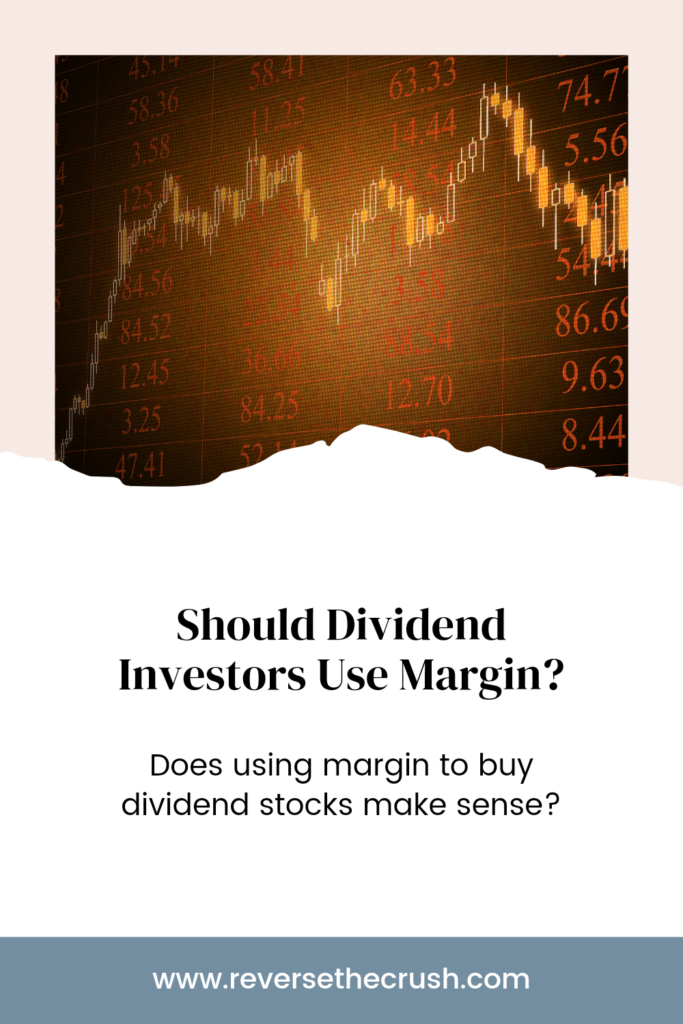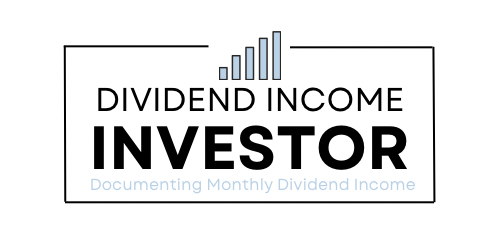Should Dividend Investors Use Margin? – Does using margin to buy dividend stocks make sense? It is possible to pay the interest off with dividends? This post contains affiliate links. I am not a licensed advisor and this post is not financial advice. This is for entertainment purposes only.
Should dividend investors use margin?
Does using margin to buy dividend stocks make sense?
Admittedly, I do not use margin to invest in my personal dividend income portfolio.
In fact, I have never used margin to acquire long-term positions.
But I have used margin to day trade crude oil futures. At one point, I moved my dividend portfolio to a margin account and traded with the margin excess.
Although I am no longer day trading, I did learn a lot of valuable lessons about the technical side of investing. It also helped me understand how to utilize margin.
In this post, I will look at using margin to buy dividend stocks and determine if it makes sense for dividend investors.
Let’s dive in.

What Is Margin?
In short, margin is a loan based on the value of your own stocks. The loan amount is determined by the quality and value of the stocks in your portfolio.
For example, if you hold a large market cap stock, typically, you can borrow up to 70% of the value of the position size. If you have $10,000 in a position, you can technically access $7,000 to trade or invest with.
But this is where it gets interesting—you pay interest on the amount you borrow. Therefore, an additional interest rate can eat into your returns on top of the commission fees.
If you are looking for a good margin account to buy dividend stocks or to trade, I would recommend Questrade. I used Questrade to trade in the past. They have low fees and offer all the tools you need. Use my special Questrade offer to get $50 worth of free trades.
The Risk Of Using Margin To Acquire Equities
Regarding the disadvantages of margin, the wrong stocks or the wrong market can put you in a position that is referred to as a “margin call.” Essentially, you get a call from your broker that you owe them money and will be forced to sell all or part of your position to pay it back. Of course, the other option is to contribute cash to the account to pay off what is owed.
This situation could occur if the market declined by 50%. If the market crashed with an outstanding margin position, the stocks you borrowed on could be worth 50% less. In turn, the amount that you originally borrowed may end up being double what you are allowed to borrow. There is a lot of risk associated with investing on margin.
Advantages Of Margin (Access To Capital)
As I mentioned above, certain stocks will allow you to borrow up to 70% of their value.
If an opportunity presents itself, you have the capital to invest through margin. Simply put, margin provides a lot more buying power.
However, it also means that you will pay an interest on the amount you borrowed. Since the interest rate is calculated daily, it doesn’t make sense to buy on margin unless the dividend rate covers the interest rate.
In other words, if you do decide to act on an opportunity with margin, it’s best to acquire companies that will cover the interest payments with dividends. That’s my opinion, though. And it’s based on my personal investment strategy. Either that or have a strategy to be out of the position by a calculated amount of time. After all, there’s no point in investing unless you’re making money.
Should Dividend Investors use Margin? Does Using Margin To Buy Dividend Stocks Make Sense?
Yes, it makes sense to use margin to buy dividend stocks if the dividend yield is higher than the margin interest rate. Additionally, it makes sense under two conditions: The investor has no debt and when real interest rates are negative.
In my opinion, the only way it makes sense to use margin is if you have no significant debt, or if real interest rates are negative.
If you have no debt, you can afford to take on more risk. So, if you are absolutely certain you will make money through a tested strategy, using margin to buy dividend stocks makes sense, especially if the interest rate is lower than dividend yield.
Taking on debt to invest in rarely advised, unless for tax purposes. Investing in the stock market is risky enough on its own. The addition of leverage increases the amount of loss an investor can incur by a tremendous amount.
The other scenario when it makes sense to use margin to buy dividend stocks is when real interest rates are negative. In this environment, a margin loan can become an asset. In short, investors can get paid to borrow because the dividend yield is greater than the interest on the margin loan.
As such, using margin to buy dividend stocks does make sense if an investor has no significant debt, or when real interest rates are negative.
Using Margin To Trade (Pay Back The Margin Loan Immediately)
Back when I was trading crude oil futures (I can hardly believe I did that now), I was able to pay my margin off immediately because I sold the position everyday.
The sum of money I had allowed me to trade with 5 figures. I was honestly taking on too much risk. But I used a practiced strategy and I was comfortable setting up stop limits. It worked surprisingly well, to tell you the truth.
Overall, I made money I had to report for tax purposes. But it was the inconsistency combined with the lower paydays that made it difficult to trade full-time.
Down the road I may allocate a 5% sector for trading and speculating again. But since I’m not day trading now, the only way I would use margin is if I could pay it back immediately.
Using Margin For Dividend Investing
A margin account could be used to buy quality dividend stocks using the margin excess. Then, the dividend income could pay off the margin loan. After the margin loan is paid off, the dividend stock could be transferred in-kind to a registered account.
Prior to 2020, I worked for a company that provided a stock sharing plan.
Since I opted to hold my stock sharing plan in a non-registered account, it would be easy for me to in-kind transfer my shares to a margin account. This was intentional.
Based on the number of shares I accumulated in my non-registered account, I have a decent figure to use for buying opportunities.
In theory, I could purchase shares of a company in a margin account that is eligible for registered accounts. After purchasing the company in the margin account, I could in-kind transfer those shares over to a registered account to receive the tax benefits of the contribution. Of course, I’d have to pay off the margin balance. But it does provide a way to acquire shares in rare circumstances, and it could potentially be advantageous for tax purposes depending on your situation.

Should Dividend Investors use Margin? – Concluding Thoughts
After years of experience with your own hard-earned money, a margin account can be a great way to take your wealth to the next level.
But investing with a margin account should be approached with tremendous caution.
At this point in my investing career, I am not using margin to build my portfolio. I am focussed on saving more, spending less, and being consistent to acquire more stocks.
However, down the road, and ideally after a market correction, I do plan to utilize margin in some cases.
To sum it up, dividend investors can use margin to buy stocks when the dividend yield is higher than the margin interest. This way, you can pay off the margin loan with dividends.
Of course, try to avoid paying interest, use margin for tax advantages if possible, and approach it with tremendous caution.
Ultimately, it is possible to use margin to provide a boost to dividend income, and this could be used to reach financial independence faster.
Dividend Investors: Do you ever use margin to acquire positions? Do you think margin can be utilized to boost dividend income?
Related Articles On Investing And Dividend Investing
How Much Do I Need To Live Off Dividends?
Types Of Investors In The Stock Market
What Makes A Good Investor? Top 20 Characteristics
Investor vs Trader: What’s The Difference And Which Is Right For You?
Dividend Investing Tips: 9 Must-Know Tips For Dividend Investors

Disclosure: All opinions are my own. I am not a licensed investment or tax advisor. This site is intended for entertainment purposes only. Blog posts about investments are not recommendations to purchase equities. You should always do your own due diligence and consult a licensed advisor before investing. This post contains ads by Google Adsense.
Connect with RTC
Twitter: @Reversethecrush
Pinterest: @reversethecrushblog
Instagram: @reversethecrush_
Facebook: @reversethecrushblog
Email: graham@reversethecrush.com


 Investor vs Trader: What’s The Difference And Which Is Right For You?
Investor vs Trader: What’s The Difference And Which Is Right For You?
